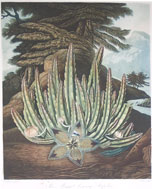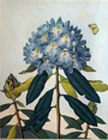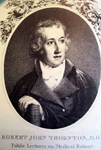
(Click images to enlarge and for purchase information.) Want to know more about prints? |
||||
|
Robert John Thornton’s (1768-1837) father was Bonnell Thornton, a physician and a well-known, successful writer whose translation of 5 of Plautus’ plays was highly praised by Robert Southey, England’s Poet Laureate. The son was destined for the Church, but his attraction to medicine won out. After three years at Guy’s Hospital and study abroad, he put up his shingle as a doctor in London in 1797. In May 1798 he was already at work on part of his opus, publishing plates of “The Tulips” and “ The Aloe”. Thornton was introduced to botany through his medical lectures (all medicine was botanically derived) and the writings of the Swede, Carl Linnaeus (1707-1779), the founder of the binomial nomenclature for natural history taxonomy and the leading botanical scientist of the 18th century. Linnaeus’ publications, Systema Naturae & Species Plantarum, had an enormous scientific impact. during this period. Thornton, like many of his peers, who were educated, prosperous and scientifically curious, developed a similar passion for Natural History, especially botany. He combined his passion with a national patriotism, which culminated in a desire to create the greatest botanical publication of all time. His goal was a work that would bring glory not only to Thornton, but also to Great Britain and its People during the period of the Napoleonic Wars, which was also a time when French Natural History publications were famous. Thornton’s opus was entitled The New Illustration of the Sexual System of Linnaeus, and contained as its third part The Temple of Flora, which was to become the most famous Florelegia of all time. Thornton hired distinguished artists, among them, Peter Henderson (17?-1829), Phillip Reinagle (1749-1833) and Abraham “Moonlight” Pether (1756-1812) along with England’s best engravers to produce the most lavish and dramatic of all botanical publications. Thornton chose plants, many very exotic, to illustrate Linnaeus’ taxonomy, a system which consisted of counting pistils and stamens to group and distinguish plants. He dictated that the plants be portrayed in very dramatic ways reflecting the current popularity of the Gothic novel. A variety of intaglio processes were used to create the plates; mezzotint, aquatint, engraving, etching and stipple (See glossary – Want to know more about prints). The plates were then individually color-printed and finished by hand. Production of the 34 colored plates took nine years with plates being issued as they were completed. Like all 17th, 18th, and early 19th century colored-plate publications, the prints for The Temple of Flora were very expensive. Unfortunately, sales of the plates were not sufficient to defray expenses and Thornton was on the verge of bankruptcy. Sadly, this was an often-repeated scenario for publishers of lavish color-plate works. Thornton, following a precedent set in 1805 by Alderman Boydell, who had persuaded Parliament to authorize a national lottery to enable him to dispose of the original paintings from his famous Shakespeare Gallery; hoped to recoup his tremendous expenses. He persuaded influential friends to back him and in May 1811 the necessary Parliamentary Act received the Royal assent. It provided for the “Botanical Lottery, for the promotion and encouragement of Science” to be drawn between 1 August 1811 and 1 December 1813. 42, 000 British pounds were to be raised by the sale of 20,000 tickets and The Temple of Flora copper plates were to be destroyed within a month of the draw. Each purchaser, as an incentive to spur ticket sales, would also receive an engraving of the Russian Tsar who had presented Thornton with a ring for his achievements. Thornton also began work at this time on a smaller size (Quarto 15”x11”), less costly version of The Temple of Flora in hopes that it would sell. The Lottery date was fixed for 6 May 1813. The Grand Prize would be the original paintings, including the full-length portrait of Linnaeus in his Lapland dress, almost all of which are now lost. The Capital Prizes: 2nd were sets of the complete New Illustrations…. including The Temple of Flora and 3rd were complete sets of the colored plates. The 4th prizes were the new Quarto sized Temple of Flora The Lottery however miscarried; sales were not sufficient to save Thornton from financial ruin. He continued to publish botanical works, but lived in comparative poverty until his death in 1837. “What Redoute, produced under the patronage of L’Heriter, Marie Antoinette, the Empress Josephine, Charles X and the Duchesse de Berry, Thornton set out to do alone,” states Alan Thomas, author, Great Books and Book Collectors. “Contrary to Thornton’s own belief that he had failed, his national undertaking had produced a lasting heirloom for the British nation,” states Ronald King, former Secretary to the Royal Botanic Gardens, Kew, the world’s foremost botanical research institution. |
||||







